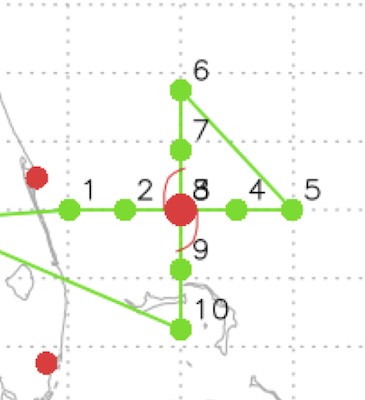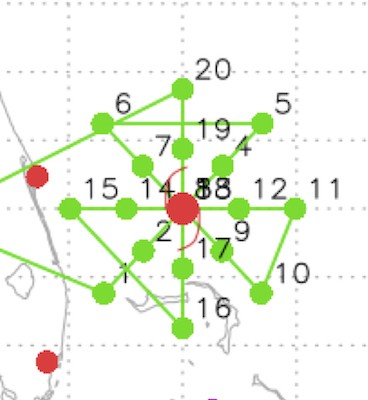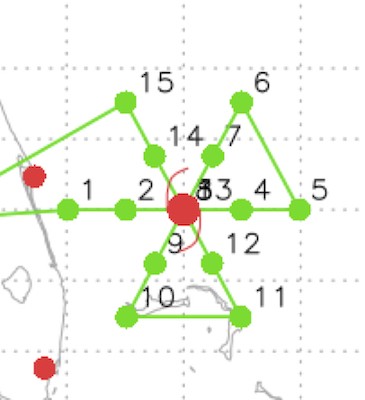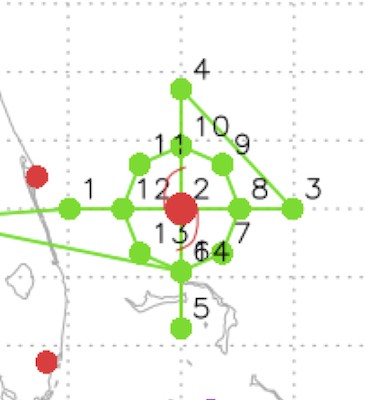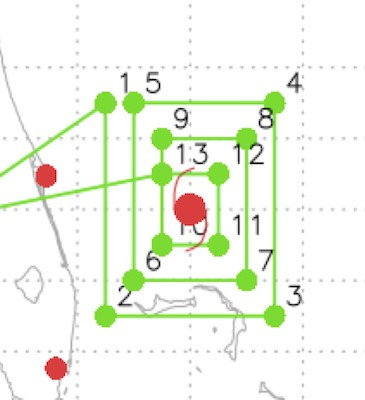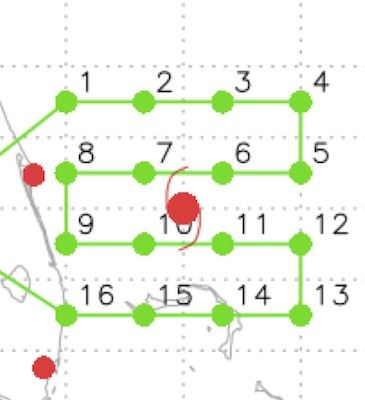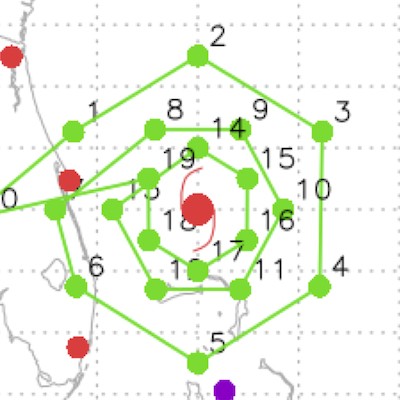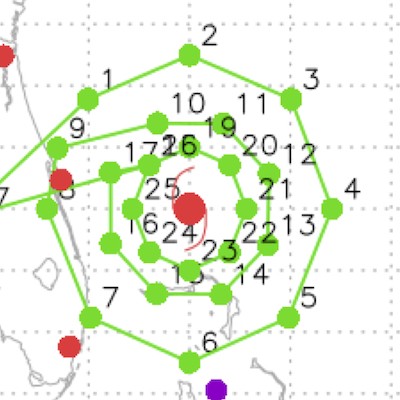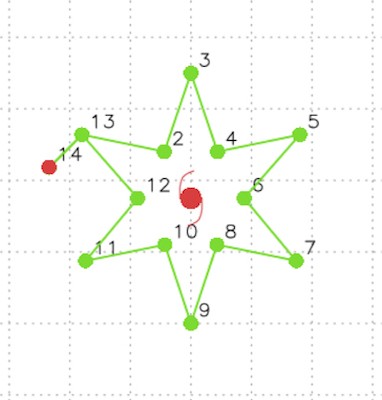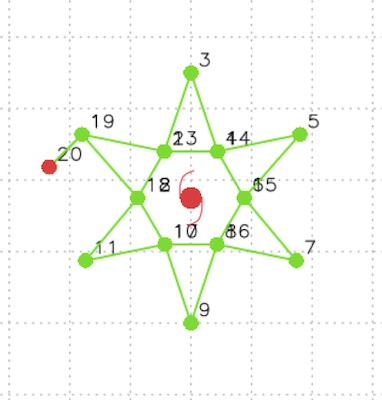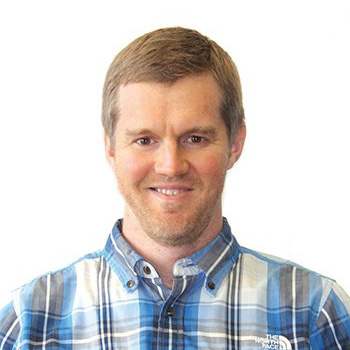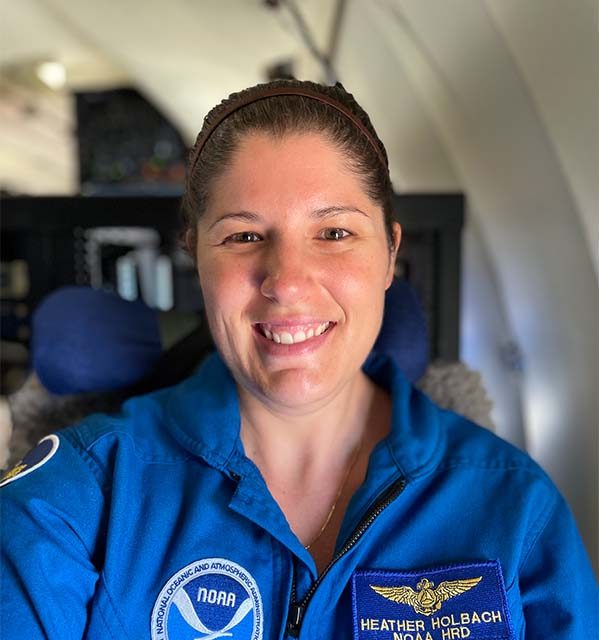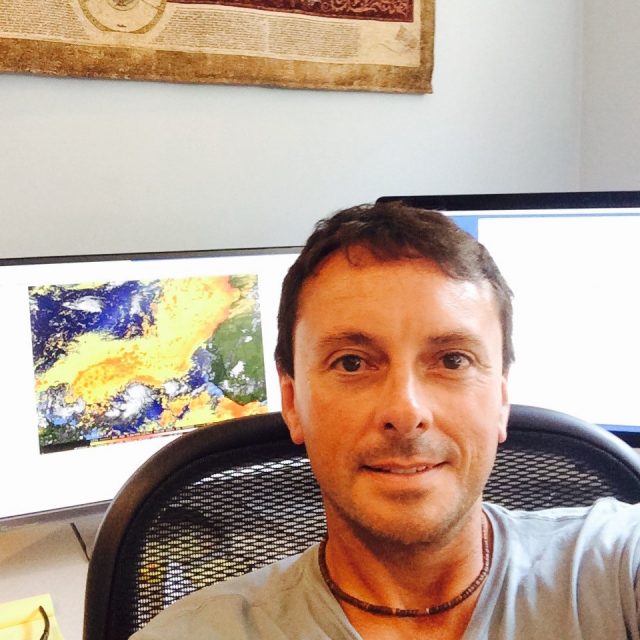Hurricane Field Program
2025 Season
The 2025 Hurricane Field Program supports NOAA’s Advancing the Prediction of Hurricanes Experiment (APHEX). This page is organized by projects that support research into the lifecycle stages of storms, from genesis to end stage, as well as ocean observations and satellite validation.
About APHEX: Developed in partnership with NOAA’s Environmental Modeling Center, National Hurricane Center, Aircraft Operations Center, and AOML’s Physical Oceanography Division, APHEX is intended to improve our understanding and prediction of hurricane track, intensity, structure, and associated hazards by collecting observations that will aid in the improvement of current operational hurricane models, such as the Hurricane Analysis and Forecast System (HAFS) model, and the development of the next-generation operational hurricane models.
We are building a Weather-Ready Nation.
Supporting NOAA Operations.
With research to operational links within the HFP-APHEX Plan and through satellite validation to enhance operational utilization of satellite data.
See How the Hurricane Field Program Supports NOAA Operations.
This document outlines the support HRD provides for operationally-tasked (EMC/NHC) NOAA hurricane aircraft missions. In the event of an operationally-tasked mission, HRD will provide support to ensure the mission achieves its goals. Click on the link below to read full documentation.
Genesis Stage
Favorable Air Mass (FAM)
Investigators
Primary Investigator: Ghassan Alaka
Jason Dunion, Trey Alvey, Rob Rogers (AP-TCRC), Sharan Majumdar (Univ. of Miami/RSMAS), Alexis Wilson (Univ. of Miami/RSMAS), Quinton Lawton (NCAR), Alan Brammer (CSU/CIRA), Chris Thorncroft (SUNY Albany), Richard Pasch (NHC), Philippe Papin (NHC)
Science Description
Although the ingredients for tropical cyclone formation have been well-documented for decades, it is still difficult to predict which disturbances will develop and which ones will not. A big factor in this uncertainty is the favorability of the air mass ahead of, and interacting with, the disturbance. This experiment proposes to collect observations of mid-level humidity and winds to assess the favorability of the disturbance’s environment for tropical cyclogenesis. These aircraft observations may also provide helpful guidance for the expanded use of satellite observations in the absence of aircraft observations.
Full Documentation
Download PDFs:
Early Stage
Stratiform Spiral Module (SSM)
Investigators
Primary Investigator: Xuejin Zhang
Trey Alvey, Michael Bell (CSU), Joe Cione (AOML/HRD), Jim Doyle (NRL), Greg McFarquhar (OU), Rob Rogers (AP-TCRC), Josh Wadler (ERAU), and Jun Zhang (UM/CIMAS & AOML/HRD)
Science Description
In early-stage tropical cyclones (TCs), the rate at which a TC intensifies is strongly related to the vertical alignment of a storm’s circulation. However, the physical processes responsible for changes in the alignment of a TC circulation are not well understood. This module aims to improve our understanding of the alignment process through the collection of relatively-high frequency observations of the three-dimensional TC structure.
Full Documentation
Download PDFs:
Vortex Alignment Module (VAM)
Investigators
Primary Investigators: Trey Alvey, Michael Fischer
Paul Reasor, Jason Dunion, Robert Rogers (AP-TCRC), David Nolan (Univ. of Miami), Daniel Stern (NRL), Zeljka Stone (New Mexico Tech Univ.), David Raymond (New Mexico Tech Univ.), Stipo Sentic (New Mexico Tech Univ.), David Schecter (NorthWest Research Associates), Xiaomin Chen (University of Alabama in Huntsville), and Rosimar Rios-Berrios (National Center for Atmospheric Research)
Science Description
In early-stage tropical cyclones (TCs), the rate at which a TC intensifies is strongly related to the vertical alignment of a storm’s circulation. However, the physical processes responsible for changes in the alignment of a TC circulation are not well understood. This module aims to improve our understanding of the alignment process through the collection of relatively-high frequency observations of the three-dimensional TC structure.
Full Documentation
Download PDFs:
Multi-Lidar Observations of the Tropical Cyclone Inflow
Investigators
Primary Investigators: Guo Lin (NOAA/AOML & UMiami/CIMAS), Jun Zhang (NOAA/AOML & UMiami/CIMAS)
Zhien Wang (SBU), Yufei Chu (SBU), Joshua Wadler (ERAU), Joseph Cione (NOAA/AOML), Sim Aberson (NOAA/AOML), Frank Marks (NOAA/AOML), Lev Looney (NOAA/AOML & UMiami/CIMAS)
Science Description
The inflow region of a tropical cyclone (TC) is critically important as it transports warm, moist air from over the ocean into the storm, providing the essential fuel needed for storm formation and intensification. However, precisely understanding how variations in inflow moisture and winds influence storm growth and intensification remains challenging due to limited detailed observations. This research module uses advanced airborne lidar instruments, including the Compact Raman lidar (CRL) and Airborne Doppler lidar (ADL), onboard the NOAA P-3 aircraft to sample high-resolution spatiotemporal 2D vertical profiles of both kinematic and thermodynamic variables along P-3 flight tracks. The goal is to better understand how moist static energy (MSE), enthalpy fluxes, and shallow convection affect early-stage TC development in shear. The multi-lidar observations will also be used to evaluate the performance of TC forecasts.
Full Documentation
Download PDFs:
Mature Stage
Distribution of Hazardous Winds
Investigators
Primary Investigators: Kelly Ryan and Heather Holbach
Science Description
Estimating tropical cyclone wind hazards can be difficult and operationally often requires assumptions to be made about surface wind characteristics relative to available flight-level observations. Approximations of surface wind using reconnaissance flight level (700 mb or 850 mb) have been routinely supported by symmetric assumptions, but observational and modeling comparisons suggest departures from this framework, occasionally detecting variations in surface winds both radially (distance from center) and azimuthally (around the storm). Data collected will be used to refine assumptions asymmetrically, estimate the uncertainty in quadrant wind radii, investigate asymmetries in the boundary layer as they relate to wind and wave hazards, and expose potential boundary layer biases in numerical weather and climate models.
Full Documentation
Download PDFs:
Eye-Eyewall Mixing
Investigators
Primary Investigators: Sim Aberson
Joe Cione, Jun Zhang
Science Description
Small features in the eyes and eyewalls of very intense tropical cyclones have been hypothesized to increase the amount of energy available for hurricane intensification, or to be responsible for damaging surface wind at landfall or intense turbulence features impacting flight operations. However, the structures of these features, especially the temperature and humidity structures, have never been documented.
Full Documentation
Download PDFs:
Gravity Wave
Investigators
Primary Investigators: Jun Zhang (PI) and David Nolan (co-PI, UM)
Science Description
Tropical cyclone (TC) convection produces gravity waves that propagate both upward and outward. The observational data collected from this module will be analyzed to quantify the characteristics of the gravity waves in mature-stage hurricanes and their relationship with storm intensity and intensity change. These data would also provide valuable information for model evaluation and physics improvement.
Full Documentation
Download PDFs:
Ocean Winds
Investigators
Primary Investigators: Paul Chang, Heather Holbach (HRD)
Zorana Jelenak, Joe Sapp, and Suleiman Alsweiss (NOAA/NESDIS/STAR);
Science Description
To improve our understanding of microwave retrievals of the ocean surface and atmospheric wind fields, and to evaluate new remote sensing techniques/technologies. To help validate satellite-based sensors of the ocean surface in extreme conditions and reduce risk for future satellite missions. To provide forecasters with near-real-time hurricane boundary layer profiles, where possible.
Full Documentation
Download PDFs:
Strategic use of Emerging Technologies To Advance Hurricane Prediction
Investigators
Primary Investigators: Joseph Cione, Josh Wadler (ERAU), Jun Zhang, Guo Lin, Xuejin Zhang, Anna Gaskill
Lev Looney, Ron Dobosy (NOAA/ARL-ret), Altug Aksoy, Sim Aberson, Frank Marks, Kelly Ryan, Brittany Dahl, David Richter (Notre Dame), Michael Bell (CSU), Don Lenschow (NCAR), George Bryan (NCAR), Josh Alland (NCAR), Rosimar Rios- Berrios (NCAR), Chris Rozoff (NCAR), Eric Hendricks (NCAR), Falko Judt (NCAR), Jonathan Vigh (NCAR), Xiaomin Chen (UAH), Johna Rudzin-Schwing (MS State), Zhien Wang (SBU)
Science Description
This experiment will leverage NOAA’s P-3 aircraft to deploy uncrewed assets into regions of the TC environment that are unsafe for crewed operations. The experimental goals are to collect detailed observations that will improve the physical understanding of hurricane structures, enhance real-time situational awareness, and, ultimately, lead to better operational forecasts of TC track and intensity. It is believed that observations from these unique platforms will improve basic understanding and enhance forecaster situational awareness. Detailed analyses of data collected from these small drones also have the potential to improve the physics of computer models that predict changes in storm intensity.
Full Documentation
Download PDFs:
Tail Doppler Radar Analysis Evaluation
Investigators
Primary Investigators: Paul Reasor
John Gamache
Science Description
Three-dimensional wind analyses derived from two P-3 aircraft equipped with tail-Doppler radar (TDR) and flying simultaneous, perpendicular transects through the hurricane eyewall are compared in an evaluation of the Doppler-radar wind analysis method. Through this evaluation, we seek to gain a better understanding of how to relate radar-derived peak wind speed and other aspects of hurricane wind structure to similar estimates using conventional observations.
Full Documentation
Download PDFs:
Ventilation Module
Investigators
Primary Investigators: Brian Tang (UAlbany), Trey Alvey, Jun Zhang
Kristen Corbosiero (UAlbany)
Science Description
Ventilation occurs when drier and/or cooler environmental air intrudes into a vertically-sheared, tilted tropical cyclone (TC). Ventilation pathways include lateral intrusion (radial ventilation) and downward intrusion (downdraft ventilation) of dry and/or cool air. Both pathways may inhibit intensification. This module aims to collect observational data to study ventilation pathways, validate model simulations of ventilation in TCs, and assess the link between ventilation and intensity changes.
Full Documentation
Download PDFs:
End Stage
Tropical Cyclones at Landfall
Investigators
Primary Investigators: Heather Holbach
John Kaplan, Jun Zhang, Ghassan Alaka, Frank Marks, Lew Gramer, Lev Looney, George Alvey, Forrest Masters (University of Florida), Brian Phillips (University of Florida), Michael Biggerstaff (University of Oklahoma), David Nolan (University of Miami), Xiaomin Chen (University of Alabama Huntsville), Johna Rudzin (Mississippi State University), John Schroeder (Texas Tech University)
Science Description
Landfalling tropical cyclones (TCs) often produce a variety of high impact weather over land including tornadoes and damaging winds (particularly gusts) for which there exists limited objective forecast guidance. Thus, our experiment seeks to utilize P-3 aircraft, land-based mobile research team instrumentation, and ocean-based uncrewed surface vehicles to collect data in landfalling TCs to improve both our understanding and capability to predict the dangerous phenomena often associated with these landfalling systems.
Full Documentation
Download PDFs:
Extratropical Transition
Investigators
Primary Investigator: Sim Aberson
Science Description
Tropical cyclones can either decay (spin down) or transform into powerful extratropical cyclones when they encounter cold water below or high wind shear in the atmosphere. The mechanisms by which tropical cyclones become extratropical is not well forecast by numerical models leading to large errors, especially in impacts downstream of the actual transitioning cyclone. This experiment aims to improve forecasts of these systems.
Full Documentation
Download PDFs:
Ocean Observing
CHAOS: Coordinated Hurricane Atmosphere-Ocean Sampling
Investigators
Priary Investigators: Lev Looney (NOAA/AOML & UMiami/CIMAS), Cheyenne Stienbarger (NOAA/GOMO), Jun Zhang (NOAA/AOML & UMiami/CIMAS), Heather Holbach (NOAA/AOML & FSU/NGI)
Maria Aristizabal Vargas (Lynker at NOAA/NCEP/EMC), Michael Bell (CSU), Luca Centurioni (SIO), Paul Chang (NOAA/NESDIS/STAR), Joseph Cione (NOAA/AOML), Gregory Foltz (NOAA/AOML), Stephen Howden (USM), Zorana Jelenak (UCAR), Hyun-Sook Kim (NOAA/AOML), Matthieu Le Henaff (NOAA/AOML), Guo Lin (NOAA/AOML & UMiami/CIMAS), Kevin Martin (USM), Travis Miles (Rutgers University), Lakshmi Miller (Virginia Tech- NSI), Theresa Paluszkiewicz (OOC, LLC), David Richter (U. Notre Dame), Johna Rudzin (Mississippi State), Joe Sapp (NOAA/NESDIS), Martha Sch.nau (SIO), Jim Thomson (APL, U. Washington), Natalia Uribe Casta.eda (NOAA/OMAO/UxS), Joshua Wadler (Embry-Riddle Aeronautical University), Dongxiao Zhang (CICOES/U. Washington & NOAA/PMEL)
Science Description
CHAOS presents a coordinated multi-platform, multi-institutional approach utilizing a diverse suite of innovative observing platforms (i.e., autonomous, uncrewed, expendable) and conventional ones (e.g., aircraft) focused on:
● Targeted coordinated observations of the air-sea transition zone, including the open ocean and coastal regions, to improve the understanding of air-sea interactions before, during, and after tropical cyclone (TC) passage for improved prediction and modeling
● Coordinated atmospheric and oceanic observations with sustained monitoring of key ocean features – e.g., major ocean currents, oceanic eddies and rings, and freshwater barrier layers.
Full Documentation
Download PDFs:
Ocean Survey
Investigators
Primary Investigators: Jun Zhang (PI, HRD/CIMAS), Nick Shay (Co-PI, UM), Elizabeth Sanabia (Co-PI, UW), Benjamin Jaimes (Co-PI, UM)
Sue Chen (NRL), Joseph Cione (AOML), Cheyenne Stienbarger (GOMO), Lev Looney (CIMAS), David Richter (UND), Michael Bell (CSU), Steven Jayne (WHOI), Joshua Wadler (ERAU), James Doyle (NRL), Gregory Foltz (AOML), Xuejin Zhang (AOML) Guo Lin (CIMAS), Heather Holbach (FSU/NGI), Martha Schonau (Scripps), Luca Centurioni (Scripps), Theresa Paluszkiewicz (OOC, LLC), Bia Villas Bôas (MINES), Henry Potter (TAMU), Paul Chang (NESDIS)
Science Description
Physical representation of how the atmosphere and ocean interact in numerical forecast models of tropical cyclones (TCs) have not been fully evaluated against observations. Near collocated and simultaneous measurements of the ocean and the atmosphere just above the ocean surface, the energy exchanges that occur between them, and how they change over time have been less understood due to lack of substantial close coordination across a wide array of ocean and atmosphere observing platforms. This experiment will provide a unique opportunity to evaluate how well coupled forecast models represent these lowest regions of storms. The new type of observations that are collected should help improve the model initialization and inform how coupled forecast models represent interactions between the ocean and atmosphere in hurricanes.
Full Documentation
Download PDFs:
SASCWATCH: Study on Air-Sea Coupling with Waves, Turbulence, & Clouds at High winds
Investigators
Primary Investigators: David Richter (PI, University of Notre Dame), Michael Bell (Co-PI, Colorado State University), Jason Dunion (Co-PI), Jun Zhang (Co-PI)
Bia Villas Bôas (Colorado School of Mines), Elizabeth Sanabia (University of Washington, Applied Physics Laboratory), Steven Jayne (Woods Hole Oceanographic Institution), Henry Potter (Texas A&M University), Johna Rudzin (Mississippi State University)
Science Description
The exchange of momentum, heat, and moisture between the ocean and atmosphere plays a central role in the presence, timing, location, and severity of extreme weather events including tropical cyclones (TCs). The experiment aims to improve our understanding and parameterization of air-sea interaction by focusing on two central elements: waves and turbulence in the TC environment. This experiment uses state-of-the art measurement and modeling platforms, while at the same time unlocking the potential of existing databases through progress in theoretical understanding. The observational work centers on co-located measurements of ocean, wave, and turbulence properties simultaneously.
Full Documentation
Download PDFs:
Satellite Validation
Synthetic Aperture Radar Wind Inspection with NOAA P-3 Data (SARWIND)
Investigators
Primary Investigators: Philippe Papin, Jason Dunion
Lisa Bucci, Eric Blake, Brad Reinhart (NHC/NWS/NOAA), Jim Doyle (NRL), Victoria Pizzini (University of Miami), Christopher Jackson, Tyler Ruff (NOAA-STAR)
Science Description
This experiment seeks to use aircraft observations to better validate high-resolution surface wind speed measurements becoming more frequently available with Synthetic Aperture Radar (SAR) polar orbiting passes. This will be accomplished by coordinating NOAA P-3 flights to occur simultaneously with an orbiting SAR pass near a TC or other ocean environments deemed research relevant to sample the wind and wave interface near the surface.
Full Documentation
Download PDFs:
TROPICS Satellite Validation
Investigators
Primary Investigators: Brittany Dahl (co-PI), Jason Dunion (co-PI), Trey Alvey (co-PI)
William Blackwell (MIT, Lincoln Laboratory), Patrick Duran (NASA MSFC SPoRT)
Science Description
This experiment is designed to calibrate and validate temperature, moisture, and precipitation measurements obtained from the new TROPICS satellites. These profiles will be compared to NOAA P-3 and G-IV aircraft observations, whose flight patterns will be coordinated in space and time with overpasses from the satellite.
Full Documentation
Download PDFs:
Operational Flight Maps

The P-3 Aircraft Operational Flight Map
Primary Atlantic operating bases and ranges (assuming ~2-h on-station time) for the P-3.

The G-IV Aircraft Operational Flight Map
Primary Atlantic operating bases and ranges (assuming ~2-h on-station time) for the G-IV.
